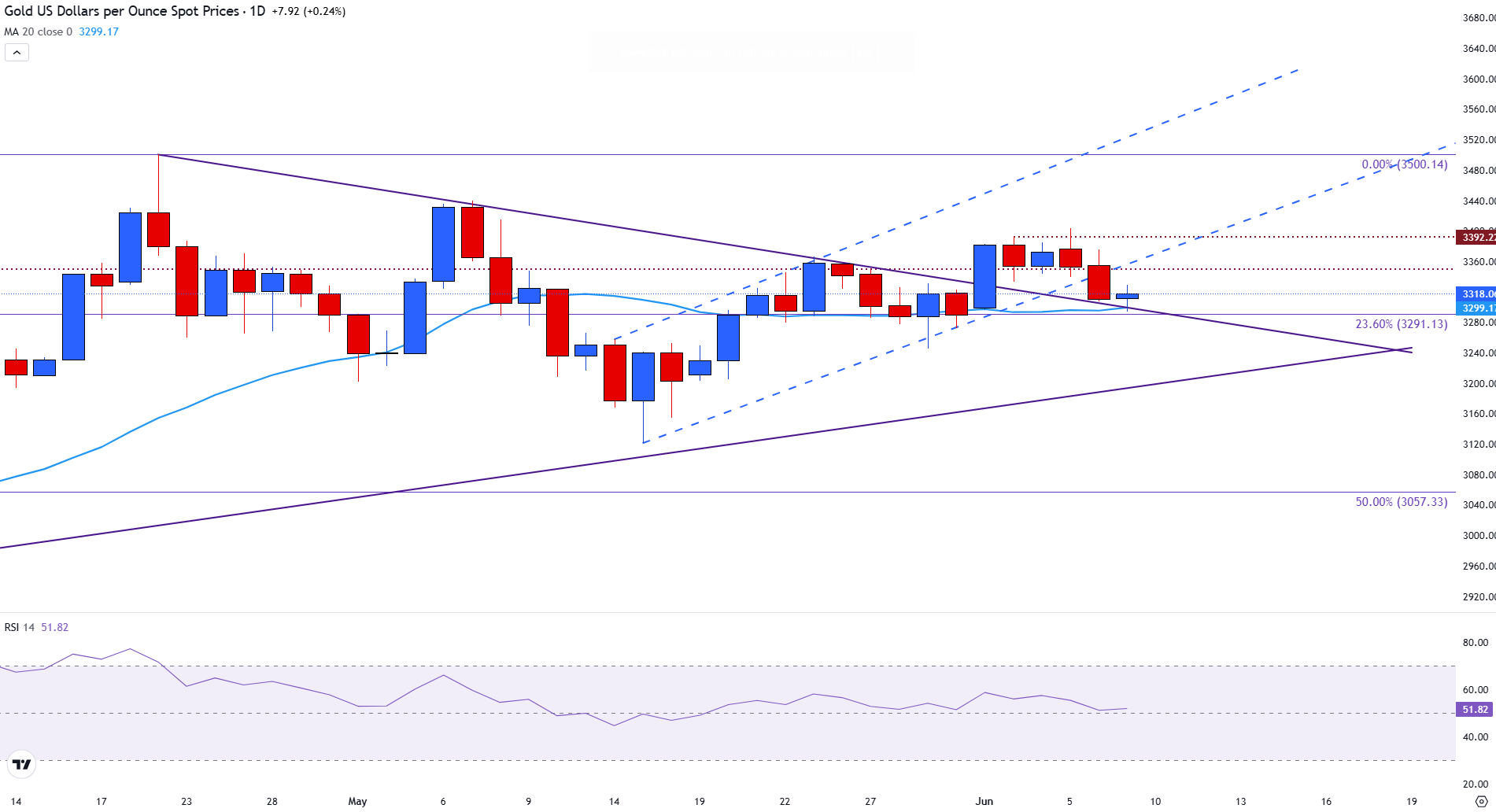- Gold edges higher as persistent trade tensions and the safe-haven appeal of precious metals boost prices.
- US-China trade talks are scheduled for Monday, remaining a key catalyst for Gold and US Dollar prices.
- Gold prices rise above $3,300 with resistance at $3,350.
Gold prices remained at an elevated level on Monday, despite the start of US-China trade talks in London. Alongside the United States’ (US) 50% tariffs on steel and aluminum imports, Gold has been supported by broader geopolitical tensions, such as the ongoing warfare between Ukraine and Russia over the weekend, which have reinforced Gold’s safe-haven status.
Gold Daily Digest: Can US-China Talks Lift Safe-Haven Gold?
- Friday’s Nonfarm Payrolls (NFP) report came in better than expected, which has eased fears of the Federal Reserve (Fed) cutting rates in the short term.
- On Thursday, Reuters reported that the Canadian Prime Minister called US tariffs “illegal,” while Mexico and the European Union expressed similar frustration.
- On Wednesday, Mexican President Claudia Sheinbaum called the new tariffs “unjust, unsustainable, and without legal grounds,” warning that if a deal is not reached, Mexico will be forced to respond with retaliatory measures.
- Canada and the EU have also threatened to retaliate if no progress is made in trade talks this week.
Gold prices remain under pressure on Monday, retreating from last week’s highs as technical indicators suggest waning bullish momentum. After failing to hold above the $3,339–$3,392 resistance zone, prices broke below short-term support near $3,320 and are now testing the 23.6% Fibonacci retracement level at $3,291. This level has become a key pivot in the near term, with a daily close below it likely to attract fresh selling pressure.
The broader price action continues to consolidate within a symmetrical triangle, suggesting indecision among market participants. The lower boundary of this pattern is currently under threat, and a confirmed breakdown could expose the ascending trendline support around $3,250–$3,260. Below that, deeper losses could take prices toward the 50% Fibonacci retracement at $3,057, a level that aligns with previous structural support.
On the upside, any rebound must clear the $3,339–$3,392 region to reassert bullish control. A break above this zone would pave the way toward the $3,500 mark, which remains the medium-term target for Gold bulls. However, with the 20-day Simple Moving Average (SMA) turning flat near $3,299, upside momentum has clearly stalled.
Momentum indicators also reflect this indecision. The Relative Strength Index (RSI) is currently hovering around 52, indicating neutral sentiment with no immediate overbought or oversold conditions. This suggests that Gold may continue to consolidate unless triggered by a major fundamental catalyst, such as updates to US interest rates or further geopolitical developments.
Gold’s technical structure has weakened slightly following the breakdown below short-term support on Friday. A decisive close below $3,291 would likely shift the outlook to bearish in the near term, while holding above the triangle base could still offer a path back toward resistance.
Gold daily chart

Gold FAQs
Gold has played a key role in human’s history as it has been widely used as a store of value and medium of exchange. Currently, apart from its shine and usage for jewelry, the precious metal is widely seen as a safe-haven asset, meaning that it is considered a good investment during turbulent times. Gold is also widely seen as a hedge against inflation and against depreciating currencies as it doesn’t rely on any specific issuer or government.
Central banks are the biggest Gold holders. In their aim to support their currencies in turbulent times, central banks tend to diversify their reserves and buy Gold to improve the perceived strength of the economy and the currency. High Gold reserves can be a source of trust for a country’s solvency. Central banks added 1,136 tonnes of Gold worth around $70 billion to their reserves in 2022, according to data from the World Gold Council. This is the highest yearly purchase since records began. Central banks from emerging economies such as China, India and Turkey are quickly increasing their Gold reserves.
Gold has an inverse correlation with the US Dollar and US Treasuries, which are both major reserve and safe-haven assets. When the Dollar depreciates, Gold tends to rise, enabling investors and central banks to diversify their assets in turbulent times. Gold is also inversely correlated with risk assets. A rally in the stock market tends to weaken Gold price, while sell-offs in riskier markets tend to favor the precious metal.
The price can move due to a wide range of factors. Geopolitical instability or fears of a deep recession can quickly make Gold price escalate due to its safe-haven status. As a yield-less asset, Gold tends to rise with lower interest rates, while higher cost of money usually weighs down on the yellow metal. Still, most moves depend on how the US Dollar (USD) behaves as the asset is priced in dollars (XAU/USD). A strong Dollar tends to keep the price of Gold controlled, whereas a weaker Dollar is likely to push Gold prices up.

